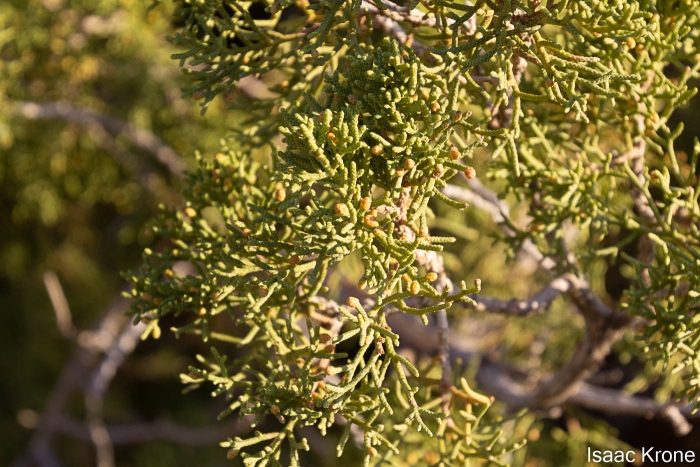California Juniper
(Juniperus californica)
California Juniper (Juniperus californica)
/
/

Isaac Krone
CC BY 4.0
Image By:
Isaac Krone
Recorded By:
Copyright:
CC BY 4.0
Copyright Notice:
Photo by: Isaac Krone | License Type: CC BY 4.0 | License URL: http://creativecommons.org/licenses/by/4.0/ | Rights Holder: Isaac Krone | Publisher: iNaturalist | Date Created: 2021-03-20T17:05:57-07:00 |





























































Estimated Native Range
Summary
Juniperus californica, commonly known as California Juniper, is an evergreen shrub or small tree native to the chaparral and scrublands of California and the Baja California region in Mexico. It typically reaches a height of 3–8 meters (10–26 feet) with a spreading habit. The bark is ashy gray, often appearing shredded or fibrous, which adds to its distinctive texture in the landscape. The foliage is bluish-gray and scale-like, providing a unique color contrast in garden settings. California Juniper produces berry-like cones that are an important food source for local wildlife.
This species is valued for its adaptability to harsh conditions, including heat and drought tolerance, making it suitable for xeriscaping. It is often used in habitat gardens, natural landscaping designs, and for erosion control on dry slopes. Additionally, its tolerance to alkali soils is notable. California Juniper is also appreciated in the art of bonsai for its rugged appearance and ability to thrive with minimal water. Cultivation requirements include full sun to part shade exposure, low to medium water needs, and well-drained soils. While it is generally disease-resistant, it can occasionally suffer from juniper blight or root rot if drainage is poor.CC BY-SA 4.0
This species is valued for its adaptability to harsh conditions, including heat and drought tolerance, making it suitable for xeriscaping. It is often used in habitat gardens, natural landscaping designs, and for erosion control on dry slopes. Additionally, its tolerance to alkali soils is notable. California Juniper is also appreciated in the art of bonsai for its rugged appearance and ability to thrive with minimal water. Cultivation requirements include full sun to part shade exposure, low to medium water needs, and well-drained soils. While it is generally disease-resistant, it can occasionally suffer from juniper blight or root rot if drainage is poor.CC BY-SA 4.0
Plant Description
- Plant Type: Tree, Shrub
- Height: 9-15 feet
- Width: 7-15 feet
- Growth Rate: Slow
- Flower Color: N/A
- Flowering Season: Non-Flowering
- Leaf Retention: Evergreen
Growth Requirements
- Sun: Full Sun, Part Shade
- Water: Low, Medium
- Drainage: Slow, Medium, Fast
Common Uses
Bird Garden, Deer Resistant, Drought Tolerant, Fragrant, Hummingbird Garden, Low Maintenance, Rabbit Resistant, Street Planting
Natural Habitat
Native to the chaparral and scrublands of California and Baja California
Other Names
Common Names: Desert White Cedar
Scientific Names: , Juniperus californica, Juniperus californica f. lutheyana, Sabina californica, Juniperus cerrosianus, Juniperus cedrosiana, Juniperus pyriformis,
GBIF Accepted Name: Juniperus californica Carrière